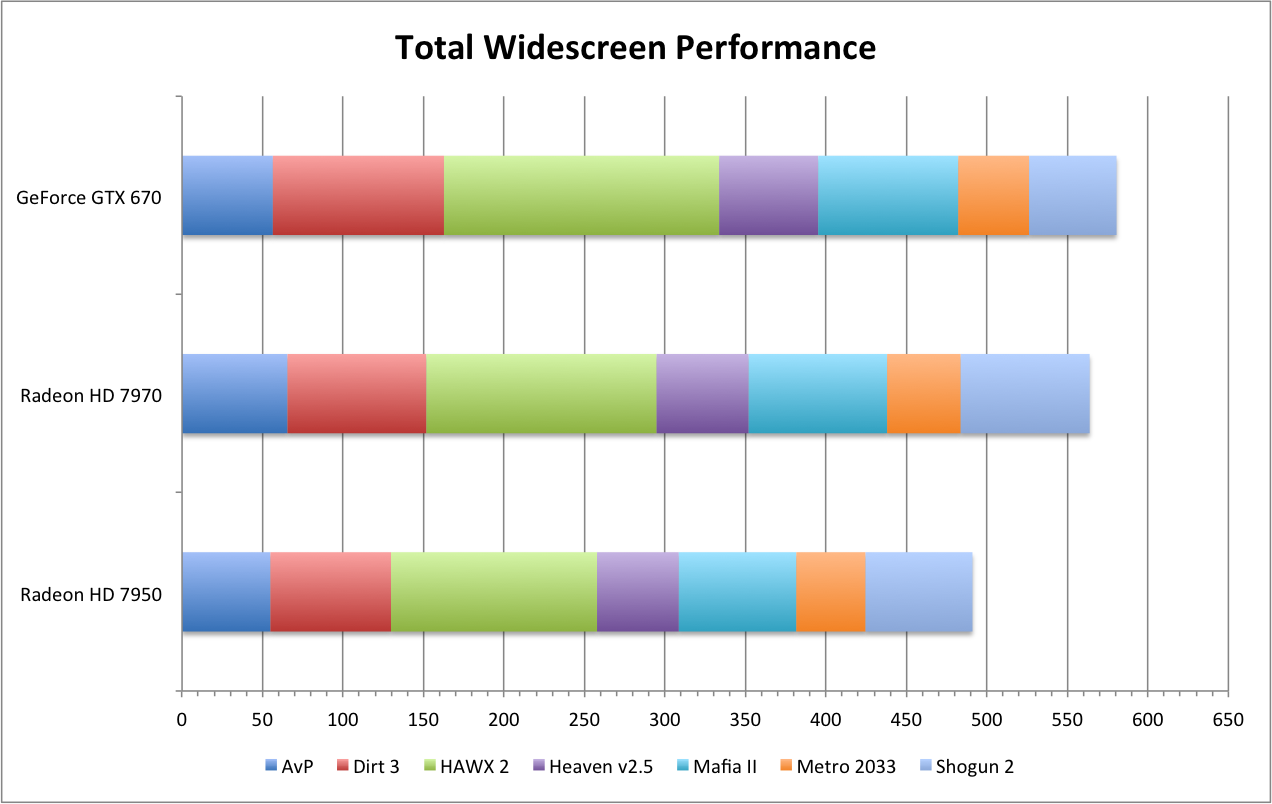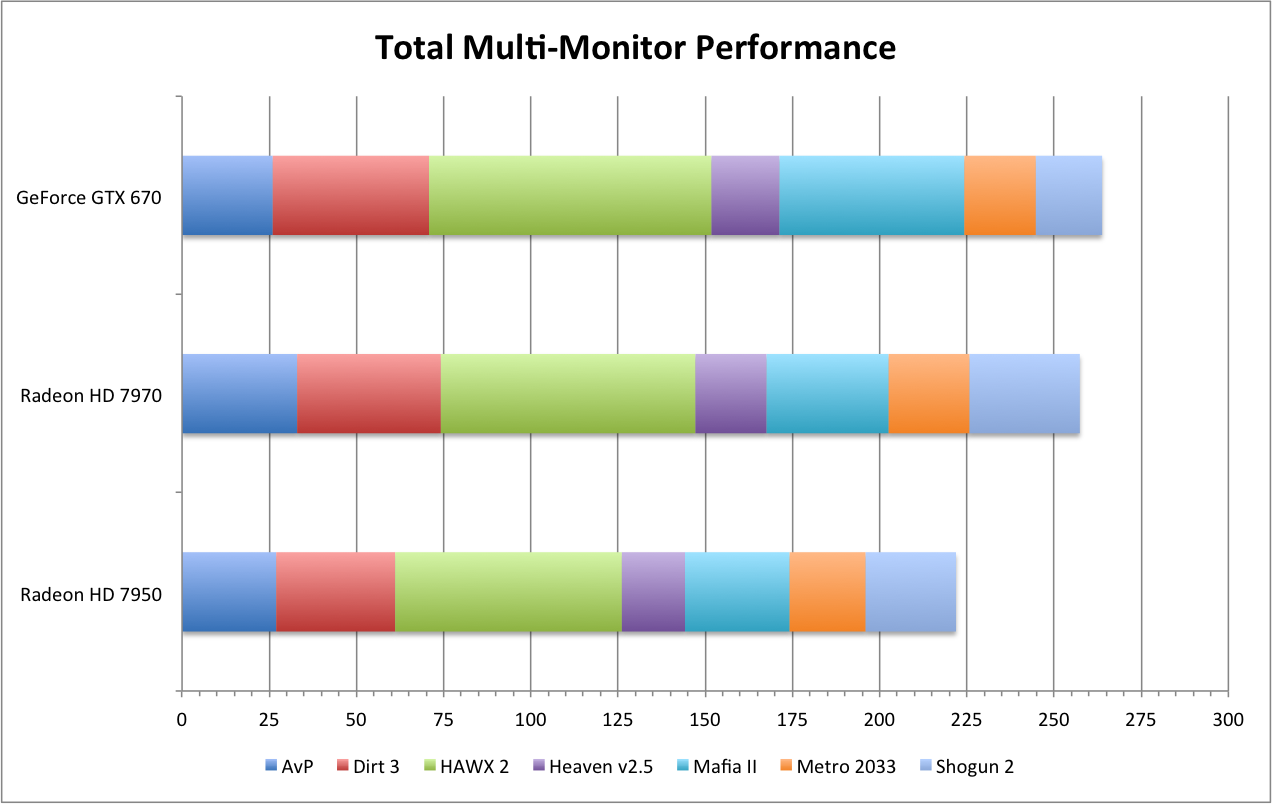NVIDIA GeForce GTX 670 Review - Heat, Noise & Final Thoughts
Noise & Heat Profile
In the past I haven't taken much time to review the noise or heat profiles of the AMD cards we've tested. You would expect that bigger cards would be louder and hotter; but without anything from NVIDIA for comparison. Now that I have card from both camps the differences in noise and heat profiles are important to investigate and discuss.
First thing you'll notice is that the GTX 670 is shorter than the AMD offerings, and much lighter. The circuit board itself is only seven inches long. The power connectors site about 2/3 down the length of the card, rather than at the end. The last 2.5 inches of the card are reserved entirely for the fan. Like the HD 7950, the GTX 670 uses two 6-pin power connectors; but it is estimated to draw 30W more power in average usage.
The back of the GTX 670 has a full-size DisplayPort connection, along with an HDMI and two DL-DVI connectors. The exhaust port is only half of one side of the GTX 670, while the exhaust ports on the AMD offerings take up one whole side. I don't have an anemometer to measure the exact air flow, but the AMD cards blow more air across a larger area. Additionally, that air is hotter. The Radeon HD 7950 blows air ranging from 120 - 130 degrees F, while the HD 7970 blows even hotter nearing 140 degrees F. The GTX blows less air, and it is cooler - not breaking 125 degrees.
The GTX ends up being slightly cooler and quieter than the Radeon HD 7950, and much cooler and quieter than Radeon HD 7970.
| Card | Volume (db) | Exhaust Temp (F) | Area Temp (F) | Length (in) | Weight |
| Ambient | 38.5 | --- | 76.5 | --- | --- |
| GeForce GTX 670 | 43.0 | 120 - 123 | 80.0 | 9.5 | 1lb. 5oz. |
| AMD Radeon HD 7970 | 49.5 | 130 - 138 | 84.0 | 11.0 | 2lb. 4oz. |
| AMD Radeon HD 7950 | 44.0 | 120 - 130 | 81.0 | 11.0 | 2lb. 3oz. |
| Noise and temperature levels taken after two passes (approx 10 minutes) of running the Heaven 2.5 Demo. The "area temp" is taken from my sitting position at my desk. | |||||
Final Thoughts


Bottom line - it's my new favorite card. Now, if I can just get my hands on a GTX 680 or GTX 690..
The GTX 670 is a great card - it's fast, quiet and cool. Even OC'd like the MSI N670GTX-PM2D2GD5/OC, the GTX 670 is simply stellar. It outperforms the reference versions of both the AMD Radeon HD 7970 and Radeon HD 7950. It's almost 20% faster than the Radeon HD 7950, and a few percent faster than the Radeon HD 7970.
The results are skewed a bit due to a couple of the "big wins". Take out HAWX 2 (for which these cards are all overkill), and the GTX 670 is only 13% faster than the HD 7950 in widescreen, and a few percent slower than the HD 7970. Take out Mafia II, and the GTX 670 is 10% faster than the HD 7950, and only a few percent lower than the HD 7970.
So, from an "sum total" viewpoint, the select of games you look at can have a bit of an impact on the results. Taking out the Shogun 2 results would make the GeForece GTX 670 look even better. Bottom line, in almost every instance the MSI OC'd GTX 670 is much faster than the Radeon HD 7950 and a hair faster than the HD 7970. It does this with being cooler and quieter than both cards, and quite a bit it's cheaper than the Radeon HD 7970.
The NVIDIA GeForce GTX 670 offers best in class performance for both widescreen and multi-monitor. Bottom line - it's my new favorite card. Now, if I can just get my hands on a GTX 680 or GTX 690...